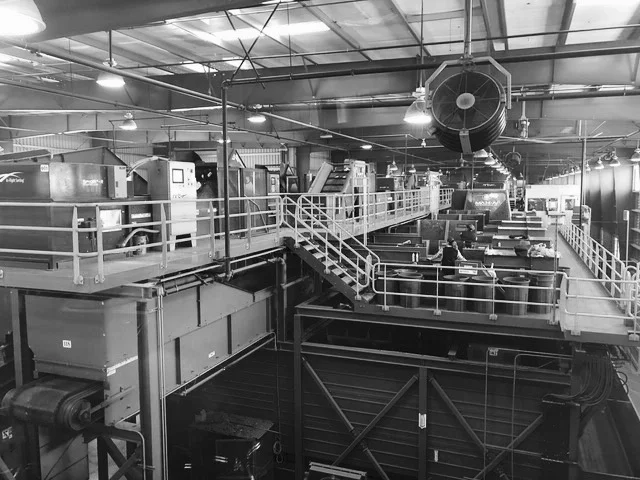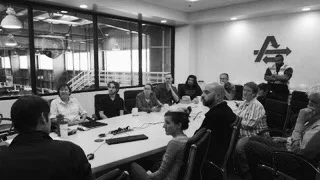Solving Global Waste Challenges Begins with Daily Choices
The following is a guest blog from Lucas Allen of All About Waste, an A/G Sustainability Consultant. This article was originally posted with USGBC-LA.
The Athens Services Material Recovery Facility (MRF) in Sun Valley, is one of the highest-tech facilities in the industry, and receives 100% of its materials from Los Angeles. If you didn’t get a chance to go on the USGBC-LA tour, there’s a video tour here that offers a cool peek at the technology they use!
The facility is impressive to say the least, utilizing a balance of people and machines to sort through large amounts of waste, for multiple shifts each day. The facility is equipped with an Optic Sorting machine that can distinguish materials by measuring the wavelength of light as it passes through, and then uses air bursts to separate the material from the rest. The new Max-AI robotic sorting arm, aiming to become more common in the industry, pulls materials out more than twice as fast as humans. There’s also a video of Max in action here.
Recycling in 2018
What happens to materials after they come into the Athens MRF? They are sorted into more than 22 different commodities, each with different destinations. Recyclable materials are often sold off to recycling facilities, many of which are located in China. Commodities like plastic bottles and mixed paper are often shipped overseas on cargo ships that would otherwise be empty, because China has been accepting tons of raw material to fuel their manufacturing boom. It has also been cost effective for people/companies that sort materials, as it’s cheaper to send material from the Port of LA to Shanghai than it is to go from the Athens MRF to the Port.
Everything changed recently when China said they would no longer accept “foreign waste,” and banned the importation of more than 24 kinds of solid waste. The flow of recyclable materials on a global scale has fundamentally changed and people in countries all over the world, including the US, need to find alternatives quickly. For many countries, this ban has already led to backlogs of increasingly large piles of garbage with nowhere to send them. A possible, major consequence of this change in the recycling market could be people resorting to incineration or landfill dumping of materials that would have otherwise been recycled.
But is it possible that China’s decision could be the push the world needs to improve local and domestic recycling operations?
Involvement
It was certainly impressive how much time, effort, and money Athens has put into the technological advancement of the MRF. Without it, the sorting process would be far more inefficient. But what does that say about people’s habits when it comes to waste? When we take a look at an example such as the village Kamikatsu in Japan, which diverts 80% of its waste from the landfill and has 34 categories of waste separation, we need to ask ourselves what we could be doing better. The Kamikatsu example is idealistic and very different in application when it comes to a city the size of LA, but what is really impressive is the buy-in and involvement of the people in the village. They know where to put their waste; it’s part of their routine, and they recognize the environmental need to be diligent about waste management.
Los Angeles already has ambitious goals to reduce its waste footprint, setting out to divert 90% of our waste from landfills by 2025. The Zero-Waste movement is gaining traction quickly on a national scale, where events like this year’s Super Bowl made a huge push to divert more than 90% of their waste. This is just the beginning, an example of what is possible with a focused effort and an activist team of people working on it. But we could be better about our buy-in and involvement. Whether it’s volunteering at beach cleanups, being diligent about reusable items, or helping somebody else be better about diverting their waste, we all have our own place in this conversation. Reflect on your waste impact and think of ways you could improve. Of the thousands of thoughts we have every day, we can certainly spare a few of them to think about ways to reduce our waste and decide where it should go.
Products made from Recycled Materials
Sorting waste efficiently is important, but it’s also one step in a life cycle that could go one of two ways after the sorting process. Either the material’s life is over and it’s never used again, or the material is recycled/reused and its life cycle continues. Closing the life cycle loop will be of ever-increasing importance in terms of future sustainability. However, if we are recycling materials and remaking them into products that are sold again, we need to support these products. Without demand, the people and companies producing them will struggle to compete with manufacturers that use virgin material.
Whether it’s purchases for you and your family, your company, or for somebody else, consider looking into options that are made from recycled materials. For all kinds of products, there are similar and competitive alternatives that are manufactured from recycled materials and are more environmentally friendly than the mainstream. Even if you are part of a manufacturing company, recycled materials may offer an equally, or even more viable solution, while also supporting the closed loop approach to material life cycles.
Some important waste takeaways from the Athens Tour
- Styrofoam:
- Avoid it whenever possible! It will end up straight in the landfill. It tends to break apart during the sorting process, is usually contaminated, and doesn’t get sorted out because there are higher priorities.
- Black/Dark Plastics:
- They don’t get sorted out by the optical sorting machine because it can’t shine light through and read the wavelength, so opt for clear or white plastics instead! The best option however, is to use reusable containers, cups, and silverware instead of the plastic disposables.
- Food Waste:
- Don’t throw it into the blue or black bins! Do your best to be efficient with food, consider donating leftovers to food collection/donation services (like some options listed here: epa.gov), and put food waste into a composting waste stream or the green bin.
- Communicate with your waste hauler:
- Waste management can be complex because it varies from region to region based on the hauler, sorting, and processing capabilities of your area. Reach out to your hauler and find out what they accept and what they don’t! Whether at home or at work, learning more about this can help increase efficiencies on both sides. If your company is making changes to products or product purchases, such as what kind of cups they use for events for example, communicate with your hauler to make sure they can accommodate the change.
Huge thanks to the people at Athens Services for the lessons and for leading the tour. Also shout out to USGBC-LA for organizing the event and working to give waste management more exposure amongst professionals in the green building industry.
Let’s all stay focused on improving our own waste habits and keep working with others around us towards a Zero Waste future!
Additional Information
- For more information about Athens and the services they provide, check out their website: athensservices.com
- For more information on LA’s Zero Waste goals and the plan, check out this website: lacitysan.org
- For more information on Zero-Waste solutions, the TRUE Zero-Waste certification, or anything else about waste, check out our website at allaboutwaste.org!
Lucas Allen is a LEED Green Associate for All About Waste, a sustainability consulting firm that specializes in Zero-Waste solutions and strives to help others towards a Zero-Waste future.


